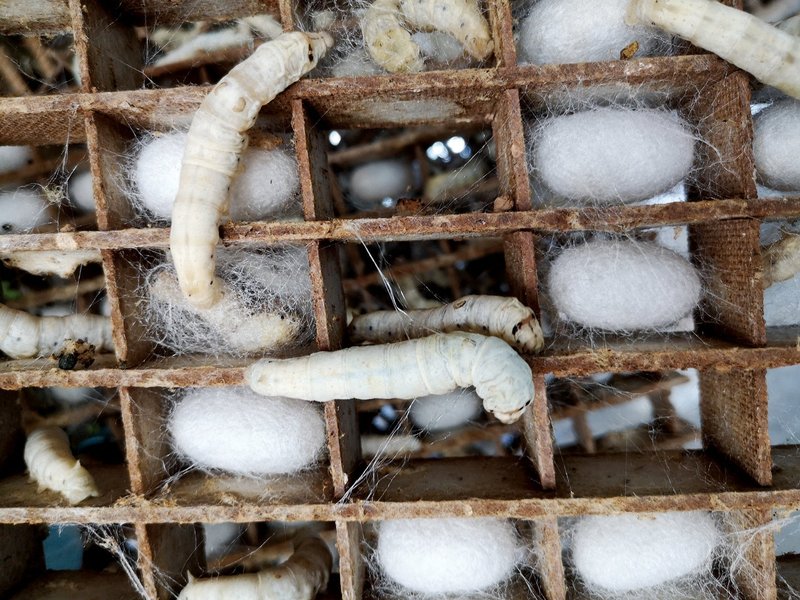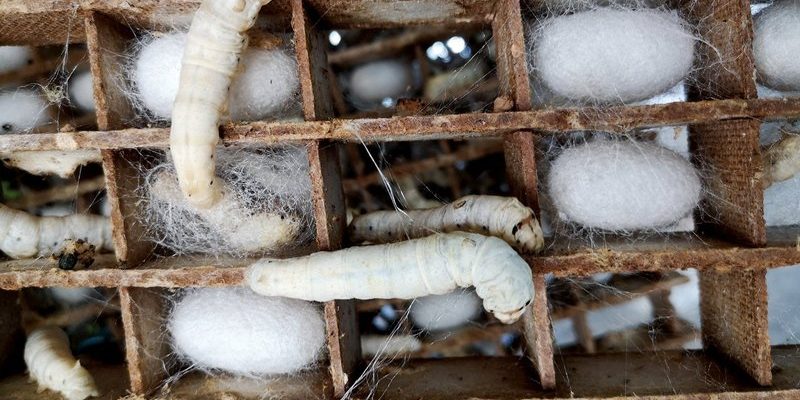
So, how exactly do these little creatures manage this incredible feat? Let me explain. When silkworms eat, they take in foliage, which helps them grow and prepares them for their next stage of life. As they reach maturity, these caterpillars enter a remarkable transformation phase, spinning silk to protect themselves. It’s a process that’s rich in history and vital to the textile industry. In this article, we’ll unravel the journey of silkworms as they create silk threads, exploring the steps and science behind this natural wonder.
The Life Cycle of a Silkworm
Before diving into how silkworms produce silk, it’s essential to understand their life cycle. Silkworms go through four main stages: egg, larva, pupa, and adult moth. The journey begins when a female moth lays hundreds of minuscule eggs. These eggs hatch into larvae, commonly known as silkworms.
During the larval stage, which lasts about 4-6 weeks, these little creatures focus solely on eating. They’re voracious eaters, primarily munching on mulberry leaves. As they grow, they shed their skin several times, a process called molting. It’s during this time that they accumulate the energy needed for their next stage—the spinning of silk.
The moment they reach maturity, silkworms stop eating. Instead, they prepare for the transformation into pupae. Here’s where the magic happens! Their bodies undergo significant changes, and they begin to spin their silk cocoons to protect themselves while they transition into the next stage of life.
The Silk Spinning Process
So, how exactly do silkworms spin silk? It starts with a special gland in their heads that produces a protein-rich substance. This substance is secreted through two spinnerets—tiny openings that work like spouts. As the silkworm draws the silk out, it combines with air, causing it to harden and form a thread.
You might be wondering, “How do they know what to do?” Honestly, it’s instinctual. Silkworms continuously spin in a figure-eight pattern, creating a cocoon around themselves. This process can take anywhere from 2 to 3 days, and during this time, they can produce over a mile of silk thread!
It’s not just any silk, either. The protein fibers that make up the silk are incredibly strong and lightweight, making them ideal for textiles. The cocoon acts both as a protective shell and as a source of raw material for silk production.
The Types of Silk Produced
Interestingly, there are different types of silk that silkworms can produce, depending on the species and their diet. The most common type is mulberry silk, spun by the Bombyx mori. This silk is known for its smoothness and luxurious feel, which is why it’s the most sought after in the fashion world.
However, other silkworm species can produce different types of silk, such as:
- Tussah Silk: Produced by wild silkworms that feed on oak leaves. It has a coarser texture and is often used in more rustic or eco-friendly fabrics.
- Eri Silk: Made from the Eri silkworm, which is known for its ability to thrive on castor plants. This silk is soft and has a matte finish.
- Muga Silk: Exclusive to India, this silk comes from the Assam silkworm and is known for its golden color and durability.
These varieties not only add diversity to silk textiles but also cater to different preferences and uses. Each type of silk carries its own unique qualities, which can be more or less desirable based on the end use.
The Harvesting Process
After the silkworms have spun their cocoons, it’s time for harvesting. This part is critical in the silk-making process. Traditionally, farmers gather the cocoons within a few days of spinning. Here’s the thing—timing is everything! If left too long, the moths will emerge from the cocoons, breaking the silk threads, which can reduce the quality significantly.
Once the cocoons are collected, they undergo a process called stifling. This involves applying heat to kill the pupae inside, preventing them from emerging. This step is crucial because it helps preserve the integrity of the silk threads.
After stifling, the cocoon threads are carefully unraveled. It’s a delicate job—imagine trying to untangle a piece of string without causing any knots. Each cocoon can yield up to 1,000 meters of silk thread, showcasing just how much work goes into creating this beautiful fabric.
The Uses of Silk Threads
Silk threads have been treasured for centuries, and their uses go far beyond just clothing. While we often see silk in high-end fashion or luxurious bedding, it’s also utilized in many other applications.
For instance, silk is commonly used in:
- Textiles: This is the most obvious use. From elegant dresses to ties, silk’s luster and smooth texture make it a favorite.
- Medical Applications: Due to its strength, silk threads are used in sutures and stitches in surgeries.
- Art and Crafts: Artists often use silk in paintings and textiles, as it absorbs dye beautifully.
These diverse uses make silk not only a luxury material but also a practical choice in various fields. It’s fascinating how one tiny creature can provide such a wide range of applications.
The Environmental Impact of Silk Production
When thinking about how silkworms produce silk, it’s also important to consider the environmental impact of silk production. Traditional silk farming practices can be resource-intensive, requiring large amounts of water and land. Additionally, the killing of pupae during harvesting has raised ethical concerns regarding animal welfare.
However, there are more sustainable practices emerging in the industry. Some farmers are now adopting ahimsa silk or “peace silk,” which allows moths to emerge from their cocoons before the silk is harvested. This approach not only supports animal welfare but also contributes to a more eco-friendly silk industry.
As consumers become more aware of the environmental footprint of their purchases, opting for ethically sourced silk can be a more responsible choice.
In summary, the journey of how silkworms produce silk threads is nothing short of amazing. From their fascinating life cycle to their instinctive spinning processes, these tiny creatures play a huge role in providing us with this luxurious fabric. Understanding the steps involved—from cocoon to fabric—deepens our appreciation for silk and all it represents.
As we embrace every fine thread of silk, let’s keep in mind the remarkable nature of silkworms and consider supporting sustainable practices in the silk industry. After all, appreciating the story behind our clothing makes every piece of silk we wear a bit more special. So, the next time you slip into something silky smooth, you can reflect on the incredible journey of those little caterpillars and the artistry of nature itself.

